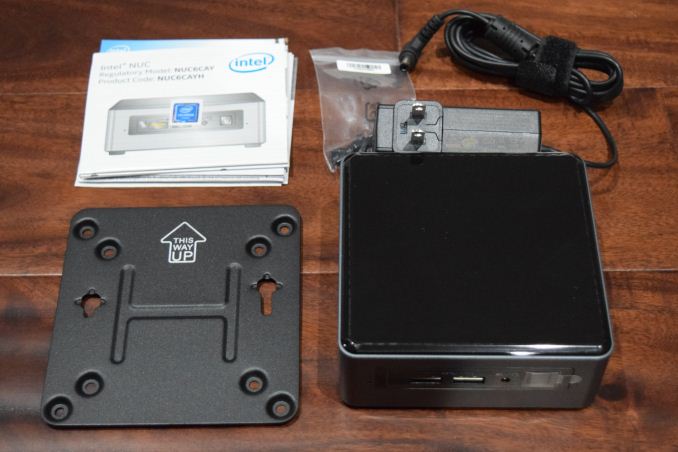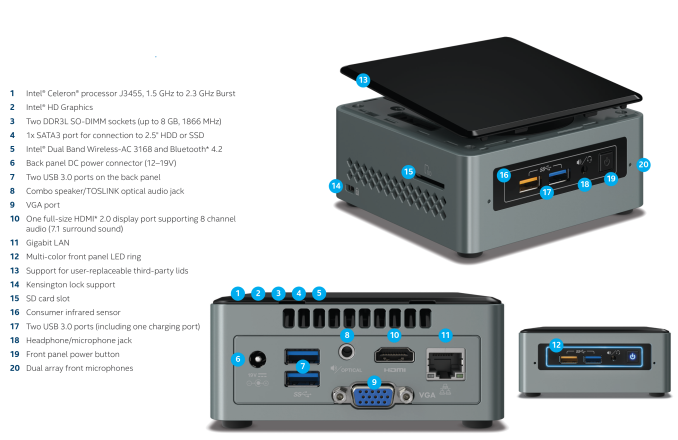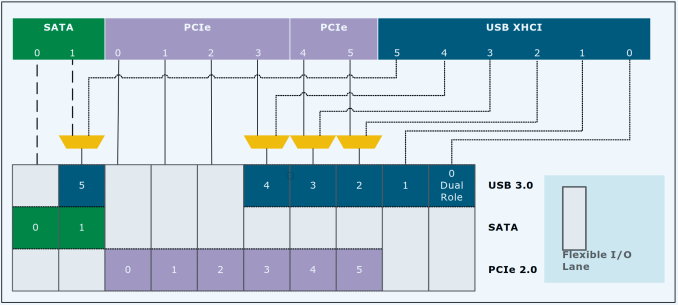Intel NUC6CAYH (Arches Canyon) Apollo Lake UCFF PC Review
by Ganesh T S on January 12, 2018 8:00 AM EST- Posted in
- Systems
- Intel
- NUC
- UCFF
- Apollo Lake
- Arches Canyon

Intel has enjoyed great success with their NUC lineup of ultra-compact form factor (UCFF) PCs. They have segmented the NUCs into three markets - the entry-level, mid-range, and enthusiast. The enthusiast segment is served by H series processors and the mid-range by the U series processors with the Core architecture. The entry level is served by Atom-class SoCs. Intel launched the Apollo Lake SoCs with the Goldmont CPU architecture in the second half of 2016. The NUC models employing one of the Apollo Lake SoCs was given the Arches Canyon codename.
Introduction and Product Impressions
The NUC6CAYH targets the entry-level and developing markets. It employs the same form factor as the previous-generation NUCs, and supports a 2.5" SATA drive (indicated by the H in the product code). Intel's Apollo Lake SoCs improve upon Bay Trail and Braswell by adopting a newer microarchitecture (Goldmont) for the CPU cores and also getting fabricated in a more power-efficient / mature 14nm process. In the consumer market, the Goldmont cores are exclusive to the Apollo Lake family. The SoCs target the netbook and nettop markets, with 6W and 10W TDP SKUs. We reviewed the ECS LIVA-ZN33 UCFF PC last year. It used a 6W TDP Celeron N3350 due to its fanless nature. The Intel NUC6CAYH, however, is actively cooled, and goes for the Celeron J3455 with a 10W TDP.
Arches Canyon has two SKUs - the NUC6CAYH, and the NUC6CAYS. The main difference between the two is that the NUC6CAYH is barebones, while the NUC6CAYS is ready to use out of the box. The 'S' SKU has a 2GB DDR3L SO-DIMM pre-installed, along with 32GB of eMMC flash on the board. Windows 10 Home x64is also pre-installed. We received the NUC6CAYH for review, and completed the configuration with a Corsair Vengeance CMSX8GX3M2B1866C10 DDR3 SODIMM kit (2x 4GB) and a 500GB Crucial MX200 SSD. The full specification of our review configuration is summarized in the table below.
| Intel NUC6CAYH Specifications | |
| Processor | Intel Celeron J3455 Apollo Lake (Goldmont), 4C/4T, 1.5 - 2.3 GHz, 14nm, 2 MB L2, 10W TDP |
| Memory | Corsair Vengeance CMSX8GX3M2B1866C10 DDR3 10-10-10-32 @ 1866 MHz 2x4 GB |
| Graphics | Intel HD Graphics 500 |
| Disk Drive(s) | Crucial MX200 CT500MX200SSD1 (500 GB; 2.5in SATA 6Gb/s; 16nm; MLC) |
| Networking | Intel Dual Band Wireless-AC 3168 (1x1 802.11ac - 433 Mbps) 1x Realtek RTL8168/8111 Gigabit LAN |
| Audio | 3.5mm Headphone Jack Capable of 5.1/7.1 digital output with HD audio bitstreaming (HDMI) |
| Miscellaneous I/O Ports | 2x USB 3.0 Type-A (rear) 2x USB 3.0 Type-A (front) 1x SDXC |
| Operating System | Retail unit is barebones, but we installed Windows 10 Pro x64 |
| Pricing | $130 (barebones) / $470 (as configured) |
| Full Specifications | Intel NUC6CAYH Specifications |
The NUC6CAYH package comes with a 65W (19V @ 3.42A) AC adapter and a VESA mount / screws in addition to the main unit.
One of the interesting aspects of the NUC6CAYH is the integrated dual-array microphone. This allows the end user to configure it as an always-listening machine (if needed), without the need to connect an external microphone. The other selling point is the availability of a HDMI 2.0 port with HDCP 2.2 support. 4Kp60 capability is present, allowing for specific digital signage use-cases. It also lends itself to usage as a HTPC capable of driving a 4K display.
Platform Analysis
The specifications of the Intel Celeron J3455 indicate that the SoC can support up to 6 PCIe 2.0 lanes, 2 SATA ports, and 8 USB ports. The break-up of the high-speed I/O lanes is interesting in the context of the four USB 3.0 ports and SDXC slot in the NUC6CAYH.
Intel Celeron J3455 HSIO Block Diagram [ Courtesy : Intel Pentium and Celeron Processor N- and J- Series Datasheet - Volume 1 of 3 (PDF) ]
The distribution of PCIe lanes in the NUC6CAYH is as below.
- PCI-E 2.0 x1 port #0 In Use @ x1 (Realtek RTS5229 PCIe Card Reader )
- PCI-E 2.0 x1 port #1 In Use @ x1 (Realtek RTL8168/8111 PCI-E Gigabit Ethernet Adapter)
- PCI-E 2.0 x1 port #2 In Use @ x1 (Intel Dual Band Wireless-AC 3168 WiFi Adapter)
Since none of the PCIe lanes are multiplexed with the USB 3.0 lanes, we do not have any bandwidth-sharing issues or bottlenecks.
In the table below, we have an overview of the various systems that we are comparing the Intel NUC6CAYH against. Note that they may not belong to the same market segment. The relevant configuration details of the machines are provided so that readers have an understanding of why some benchmark numbers are skewed for or against the Intel NUC6CAYH when we come to those sections.
| Comparative PC Configurations | ||
| Aspect | Intel NUC6CAYH | |
| CPU | Intel Celeron J3455 | Intel Celeron J3455 |
| GPU | Intel HD Graphics 500 | Intel HD Graphics 500 |
| RAM | Corsair Vengeance CMSX8GX3M2B1866C10 DDR3 10-10-10-32 @ 1866 MHz 2x4 GB |
Corsair Vengeance CMSX8GX3M2B1866C10 DDR3 10-10-10-32 @ 1866 MHz 2x4 GB |
| Storage | Crucial MX200 CT500MX200SSD1 (500 GB; 2.5in SATA 6Gb/s; 16nm; MLC) |
Crucial MX200 CT500MX200SSD1 (500 GB; 2.5in SATA 6Gb/s; 16nm; MLC) |
| Wi-Fi | Intel Dual Band Wireless-AC 3168 (1x1 802.11ac - 433 Mbps) |
Intel Dual Band Wireless-AC 3168 (1x1 802.11ac - 433 Mbps) |
| Price (in USD, when built) | $130 (Barebones) $470 (as configured / No OS) |
$130 (Barebones) $470 (as configured / No OS) |













54 Comments
View All Comments
Hulk - Friday, January 12, 2018 - link
Would it be possible to note the processor in the comparison systems in parenthesis for those of us who don't remember which system has which processor? Also it would be nice to have a fast processor in the metric (7700k or something like that) to get a gauge on how these low power processors compare.MattMe - Friday, January 12, 2018 - link
I agree with your points. Perhaps a U series would be a better comparison than a K series though?ganeshts - Friday, January 12, 2018 - link
I will keep that in mind for the next review.mode_13h - Monday, January 15, 2018 - link
The i3 from the BAPCo SYSmark seemed a good basis for comparison. Or maybe just the next more expensive NUC, in case someone is trying to decide whether to spend the extra money.Mr Perfect - Friday, January 12, 2018 - link
As an aside, does NUC packaging still come with the little light activated speaker that plays the Intel chime when you open the box? The first gen ones did, and I hid the speaker modules around the office so random things would chime when the light hit them. Good times...ganeshts - Friday, January 12, 2018 - link
Not in the new ones, unfortunately :)bi0logic - Friday, January 12, 2018 - link
won't this nuc be replaced by the June Canyon NUC(Gemini Lake) version any day now?intel says the NUC6CAYH launch was Q4 '16
https://ark.intel.com/products/95062/Intel-NUC-Kit...
ganeshts - Friday, January 12, 2018 - link
That is literally the last paragraph in my concluding section :)In any case, Intel plans to keep Arches Canyon in production till end of Q2 2018 as per official roadmaps.
mode_13h - Monday, January 15, 2018 - link
Still, I appreciate these benchmarks, since it should help show how much Gemini Lake (Goldmont +) actually improved.ilt24 - Friday, January 12, 2018 - link
Am I missing something? The $470 price with No OS seems quite high if the NUC starts at $130 and your just adding a pair of 4GB Memory modules and a 500GB SSD.